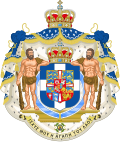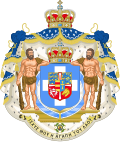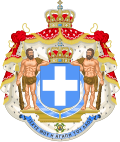| KeteranganRoyal Coat of Arms of Greece.svg |
English: Coat of arms of the Kingdom of Greece in 1936–1973
- Royal Coat of Arms of Greece under the Glücksburg dynasty, created after the restoration of King George II to the throne in 1935, to the exile of King Constantine II in 1967 and finally until the abolition of the monarchy in 1973.
- The Escutcheon features the white cross on a dark blue field of Greece. The Inescutcheon features the Arms of the Greek line of the House of Schleswig-Holstein-Sonderburg-Glücksburg. The shield is then topped with a golden Royal Crown.
- It features an escutcheon divided by the red and white cross of the Order of the Danneborg, the first quarter features the arms of Denmark (three crowned blue lions and nine hearts in yellow field). The second of Schleswig (two blue lions passant in yellow field). The third divided into four; the chief features the three royal crowns in blue field of the Kalmar Union, the second half with a crowned stockfish on red field of Iceland and the last half divided between the ram of the Faroe Islands and a polar bear of Greenland, both on blue fields. The fourth quarter is divided between two halves, the chief depicts a yellow field with a blue lion passant over nine red hearts of the King of the Goths, the lower half depicts a crowned golden lindorm on a red field of the King of the Wends.
- Upon it is another inescutcheon in red, divided into four quarters: the first a a silver nettle leaf of Holstein, the second the a swan with a golden crown of Stormarn, the third a knight dressed in golden armor on a silver horse of Dithmarschen and the fourth of a golden horse's head of Lauenburg.
- Upon it is another inescutcheon divided the first features the red and yellow bars of Oldenburg, the second a golden cross on a blue field of Delmenhorst.
- The escutcheon rests on a golden pedestal and supported by two human figures representing the Greek mythological hero Herakles (Heracles), holding a wooden club and wearing the skin of the Nemean lion.
- The escutcheon is surrounded by the ribbon and cross of the Order of the Redeemer, the cross depicts Christ Pantocrator, surrounded by the order's motto:"Η ΔΕΞΙΑ ΣΟΥ ΧΕΙΡ, ΚΥΡΙΕ, ΔΕΔΟΞΑΣΤΑΙ ΕΝ ΙΣΧΥΙ" or "Thy right hand, O Lord, is become glorious in power" from Exodus, 15:6.
- The motto of the Coat of arms and of the dynasty, depicted on a golden ribbon below the pedestal reads: "Ἰσχύς μου ἡ ἀγάπη τοῦ λαοῦ" or "The people's love, my strength"
- The coat of arms is then surrounded by a dark blue mantle and topped with another royal crown.
Français : Armes du Royaume de Grèce, de 1936 à 1973
- Armes de la dynastie de Glücksburg, créées de la restauration du roi George II sur le trône en 1935, jusqu'à l'exil du roi Constantin II en 1967 et l'abolition de la monarchie en 1973.
- Sur le blason figure la croix blanche sur champ d'azur. Devant lui, un blason plus petit figure les armes de la maison de Schleswig-Holstein-Sonderburg-Glücksburg. Il est surmonté d'une courone royale d'or.
- Écartelé : à la croix pattée d'argent bordée de gueules, qui est le Danebrog, cantonnée en I, d'or, à neuf cœurs de gueules, posés en trois pals, à trois lions léopardés d'azur, armés et lampassés de gueules, couronnés du champ, brochant sur-le-tout (de Danemark) ; en II, d'or, à deux lions léopardés d'azur, armés et lampassés de gueules (de Schleswig) ; en III, coupé : À d'azur, à trois couronnes d'or (de Union de Kalmar) et B coupé de gueules à une peau de morue d'argent tenue en pal par une traverse de sable, le tout couronné d'or et coupé d'azur à un bélier d'argent passant lampassé de gueules et armé d'or (des Îles Féroé), et d'azur à un ours polaire d'argent armé du premier (de Groenland) ; en IV, coupé d'or au lion léopardé d'azur soutenu de neuf cœurs de gueules ordonnés 5 et 4 (du Royaume des Goths) et de gueules au dragon d'or (du Royaume des Vandales) ; sur-le-tout écartelé au 1 de gueules, à la feuille d'ortie d'argent (de Holstein) au 2 de gueules, au cygne d'argent, becqué, membré et colleté d'une couronne d'or (Stormarn), au 3 de gueules, au cavalier armé d'argent (Dithmarse), au 4 de gueules à la tête de cheval coupée d'or (de Lauenbourg) ; sur-le-tout-du-tout parti d'or à deux fasces de gueules (de Oldenbourg) et d'azur, à la croix pattée, au pied fiché d'or (de Delmenhorst)
- Le blason est sur un piédestal d'or et soutenu par deux figures humaines représentant le héros mythologique grec Héraclès (Hercule), portant une massue de bois et la peau du Lion de Némée. Il est entouré par le ruban et la croix de l'Ordre du Sauveur. La croix représente le Christ pantocrator, entouré de la devise de l'ordre: « Η ΔΕΞΙΑ ΣΟΥ ΧΕΙΡ, ΚΥΡΙΕ, ΔΕΔΟΞΑΣΤΑΙ ΕΝ ΙΣΧΥΙ » (Trad.: « Ta main droite, ô seigneur, est devenue gloriause de puissance », Exode, 15:6).
- La devise des armes et de la dynastie, sur un ruban d'or sous le piédestal, est « Ἰσχύς μου ἡ ἀγάπη τοῦ λαοῦ » (Trad.: « L'amour du peuple, ma force ».
- L'ensemble est entouré d'un manteau bleu sombre et d'une autre couronne royale.
|
Kebenaran
(Penggunaan semula fail ini) |

|
This image shows a flag, a coat of arms, a seal or some other official insignia. The use of such symbols is restricted in many countries. These restrictions are independent of the copyright status.
| Dengan ini, saya selaku pemegang hak cipta karya ini, menerbitkannya di bawah lesen-lesen yang berikut:

|
Kebenaran diberikan untuk menyalin, mengedar dan/atau mengubah dokumen ini di bawah syarat-syarat Lesen Pendokumenan Bebas GNU, versi 1.2 atau mana-mana versi selepas ini, yang diterbitkan oleh Yayasan Perisian Bebas; tanpa Seksyen yang Tak Berubah, tanpa Teks Kulit Depan dan tanpa Teks Kulit Belakang. Salinan lesen ini boleh didapati dalam seksyen yang bertajuk Lesen Pendokumenan Bebas GNU".http://www.gnu.org/copyleft/fdl.htmlGFDLGNU Free Documentation Licensetruetrue
|
- Anda bebas:
- untuk berkongsi – untuk menyalin, mengedar dan memindah hasil kerja
- untuk mencampur semula – untuk menyesuaikan karya
- Di bawah syarat berikut:
- pengiktirafan – Anda mesti memberi penghargaan yang berpatutan, bekalkan pautan ke lesen, dan tunjukkan jika perubahan telah dibuat. Anda boleh lakukannya dalam sebarang cara yang munasabah, tetapi bukan dalam sebarang cara yang mencadangkan pemberi lesen mengendors anda atau penggunaan anda.
- perkongsian serupa – Jika anda mengubah, adun semula, atau menokok tambah bahan, anda mesti menyebarkan sumbangan anda di bawah lesen yang sama atau serasi dengan yang asal.
https://creativecommons.org/licenses/by-sa/3.0CC BY-SA 3.0 Creative Commons Attribution-Share Alike 3.0 truetrueAnda boleh memilih mana-mana lesen yang anda mahukan.
| Public domainPublic domainfalsefalse
|

|
This image (or other media file) is in the public domain because its copyright has expired and its author is anonymous.
This applies to the European Union and those countries with a copyright term of 70 years after the work was made available to the public and the author never disclosed their identity. Important: Always mention where the image comes from, as far as possible, and make sure the author never claimed authorship.
 Note: In Germany and possibly other countries, certain anonymous works published before July 1, 1995 are copyrighted until 70 years after the death of the author. See Übergangsrecht. Please use this template only if the author never claimed authorship or their authorship never became public in any other way. If the work is anonymous or pseudonymous (e.g., published only under a corporate or organization's name), use this template for images published more than 70 years ago.
For a work made available to the public in the United Kingdom, please use Template:PD-UK-unknown instead.
|

| |













